Pimple patches don’t prolong healing; they actually speed it up! These patches create a moist environment that helps your skin recover, absorbs excess fluid, and keeps irritants at bay. Perfect for surface pimples, they allow for faster healing by promoting hydration. You’ll typically see noticeable changes within 24-48 hours, so they aren’t an overnight cure. If you want to know more about how to use them effectively and their benefits, keep going!
Key Takeaways
- Pimple patches do not prolong healing; they create a moist environment that promotes faster recovery of surface-level pimples.
- Hydrocolloid patches absorb fluid and impurities, which aids in reducing inflammation and speeding up healing.
- They act as a protective barrier, preventing picking and minimizing the risk of scarring during the healing process.
- Misconceptions suggest patches dry out the skin, but they actually maintain hydration, which is essential for effective healing.
- Noticeable improvements typically occur within 24-48 hours, confirming their effectiveness rather than prolonging the healing time.
Understanding How Pimple Patches Work
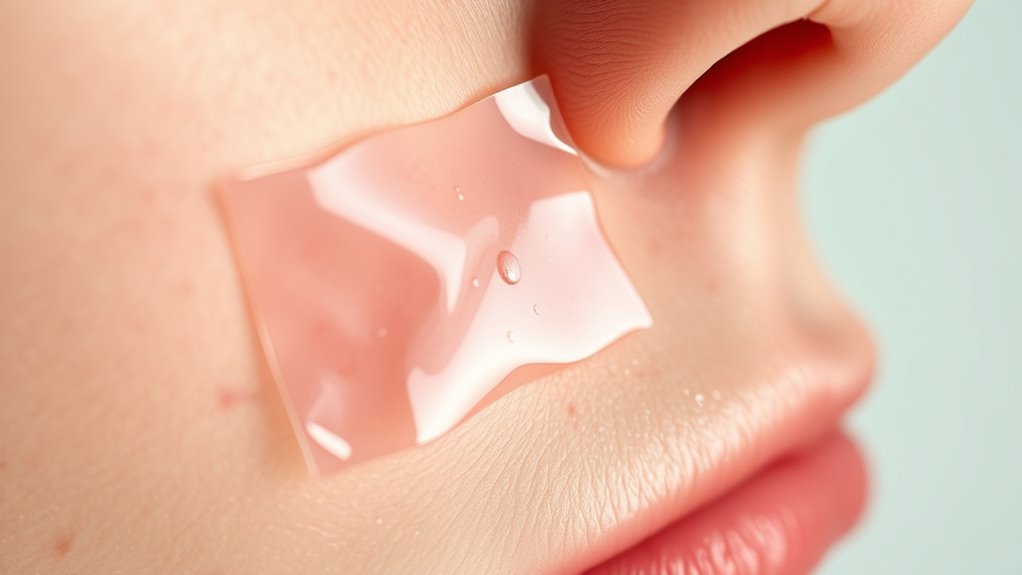
When you apply a pimple patch, it works by using hydrocolloid material to create a moist environment that accelerates healing.
This gel-forming material absorbs excess fluid, drawing out pus and impurities while acting as a barrier against irritants and bacteria. Hydrocolloid patches absorb fluid or pus, changing color to white or cloudy when effective, which indicates their moisture-absorbing properties that facilitate healing.
By keeping the affected area hydrated, the patch promotes ideal healing conditions and prevents the exudate from spreading.
You’ll find that some patches include active ingredients like salicylic acid or tea tree oil, which help reduce inflammation and fight acne-causing bacteria.
These patches not only minimize the size and redness of surface-level pimples but also discourage you from picking or popping them, ultimately reducing the risk of scarring and promoting quicker recovery.
The Effectiveness of Different Types of Pimple Patches
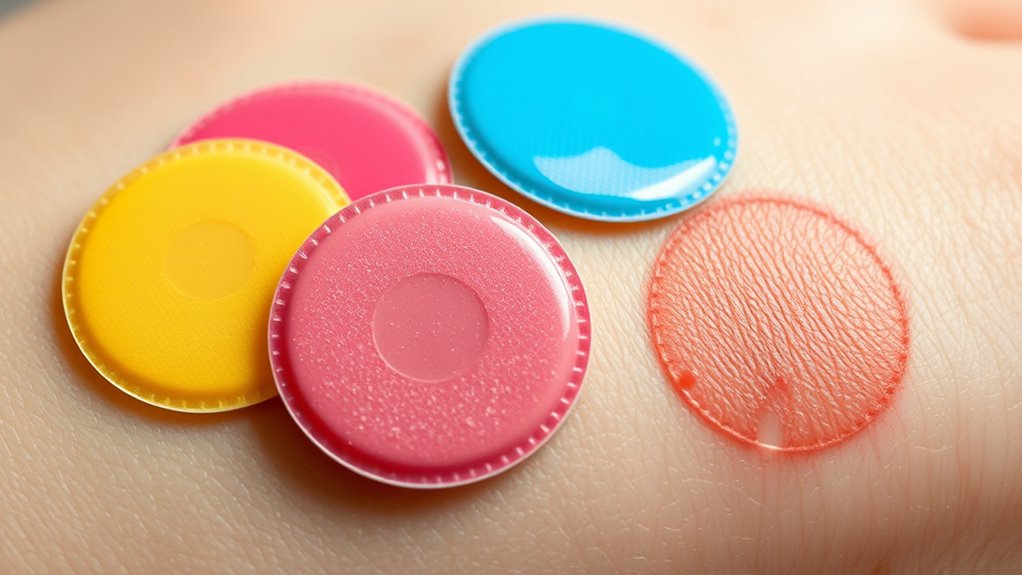
How effective are the various types of pimple patches available today? Different patches offer unique benefits.
Hydrocolloid patches excel at absorbing fluid, speeding up healing, and reducing inflammation, making them ideal for surface pimples. They are made of hydrocolloid, a gel-forming material that helps draw out excess oil and pus. Regular use of herbal tea may also contribute to skin health by providing antioxidants, while incorporating glycolic acid can further enhance skin texture and tone. Additionally, using patches with tea tree oil can help target acne-causing bacteria effectively.
Hydrocolloid patches are perfect for surface pimples, effectively absorbing fluid and reducing inflammation for faster healing.
Salicylic acid patches help unclog pores and reduce redness but can irritate sensitive skin.
Tea tree oil patches target acne-causing bacteria, providing antibacterial support.
For severe acne, microneedling patches deliver ingredients deeper into the skin for enhanced effects.
Combination patches blend multiple ingredients, maximizing benefits.
While brands like Hero Cosmetics and COSRX are popular, remember that most patches aren’t effective for cystic acne.
Ultimately, choosing the right patch depends on your specific skin needs and the type of acne you’re dealing with.
Factors That Influence Healing Time
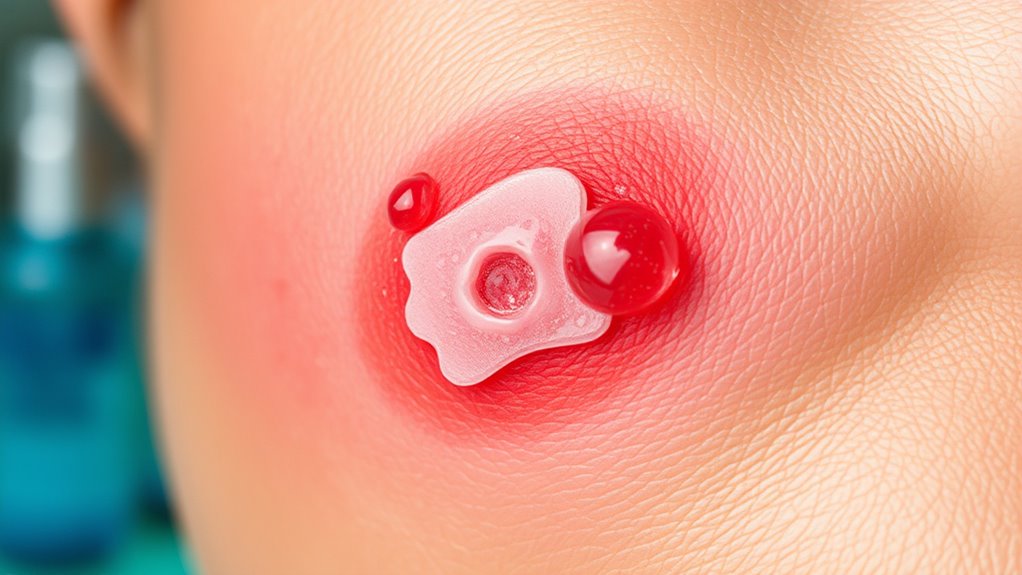
Several factors influence the healing time of acne, and understanding them can help you manage breakouts more effectively.
Your skin type plays an essential role; if you have oily skin, excess sebum can slow healing. Hormonal changes, especially during your menstrual cycle, can worsen acne and prolong recovery. Diet matters too—high sugar and dairy can exacerbate breakouts and delay healing. Additionally, using products like pimple patches can create a moist environment that promotes faster healing.
Additionally, poor sleep quality can impair your skin’s barrier function, while high stress levels can worsen your acne.
Environmental factors like humidity and air pollution also impact healing. By being aware of these elements and making informed lifestyle choices, you can enhance your skin’s healing process and reduce the duration of those pesky breakouts.
Common Misconceptions About Pimple Patches
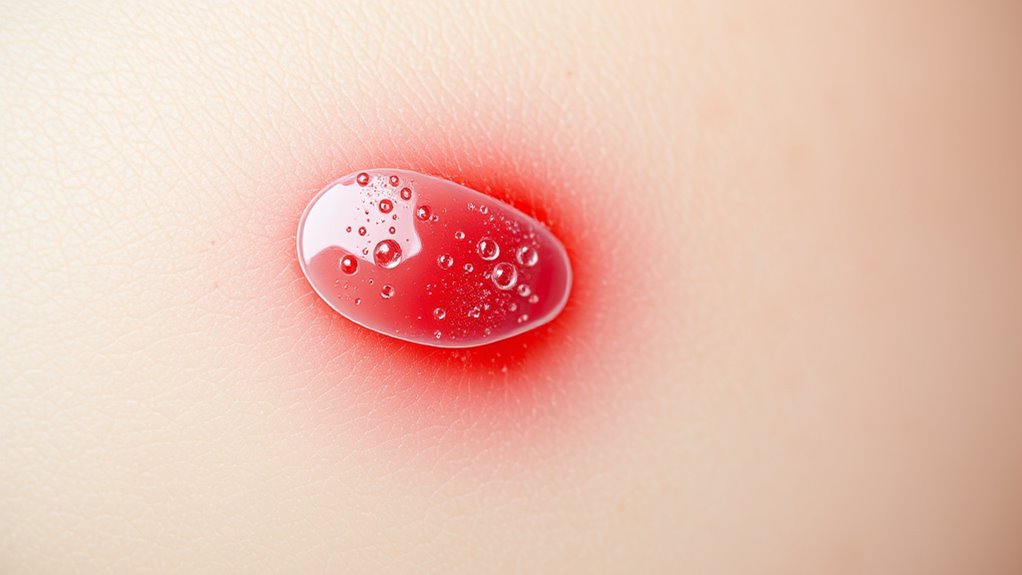
Understanding the factors that influence healing time can set the stage for addressing common misconceptions about pimple patches. Many people think these patches work on all acne types, but they’re most effective for surface-level pimples, not deeper cystic acne. It’s also a myth that patches can cure acne; they’re a quick fix for individual spots. Contrary to popular belief, hydrocolloid patches create a moist environment that aids healing rather than drying out the skin. Additionally, they are designed for targeted application on blemishes, ensuring optimal effectiveness. While some assume they’ll see overnight results, noticeable changes typically take 24-48 hours. Remember, pimple patches complement your skincare routine and can’t prevent future breakouts. Finally, they provide a protective barrier, which can help minimize scarring by preventing picking.
Best Practices for Using Pimple Patches Effectively
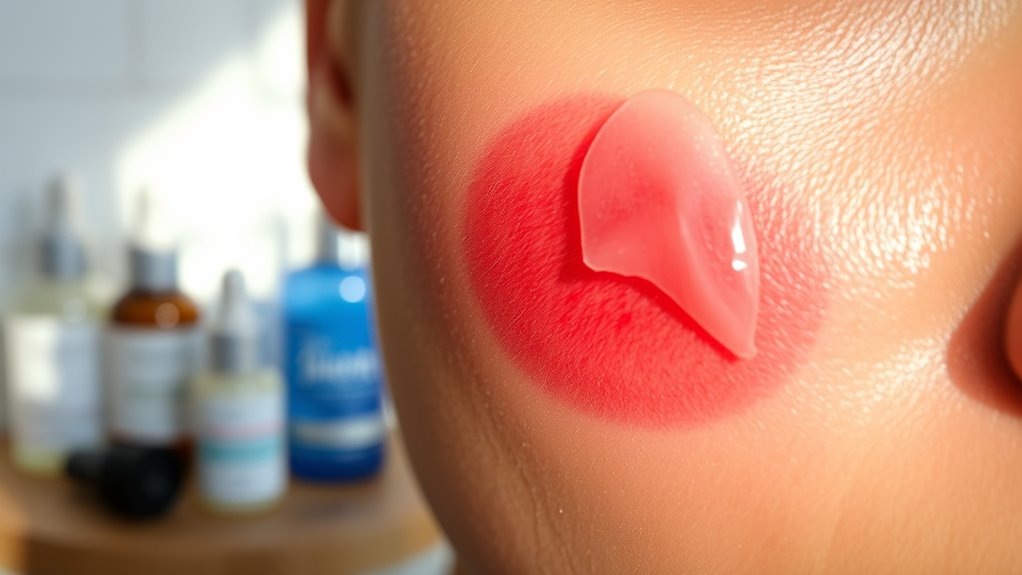
Using pimple patches effectively can greatly enhance their healing benefits, and following a few best practices will guarantee you get the most out of them.
Start by cleansing your skin thoroughly and patting it dry to confirm the patch adheres well. Choose a patch suited for your specific pimple type and apply it immediately after cleansing to maximize effectiveness. Pimple patches are designed for targeted treatment of breakouts, making them a convenient option for treating individual, surface-level pimples. Ensure that your skin is in an environment with optimal air quality to avoid additional irritation during the healing process.
Be sure to press it down gently to avoid air bubbles. Follow the manufacturer’s instructions on wear time and look for signs of absorption, like a white appearance.
After removal, gently clean the area and maintain your skincare routine without harsh treatments. Finally, keep your skin hydrated to support healing.
Frequently Asked Questions
Can Pimple Patches Be Reused for Multiple Applications?
You shouldn’t reuse pimple patches.
They’re designed for single use, and reapplying them can transfer bacteria back onto your skin, increasing the risk of infections and breakouts.
After absorbing pus and oil, their effectiveness diminishes, and they may cause irritation if applied repeatedly to the same area.
For the best results, always use a fresh patch to guarantee peak healing and protection for your skin.
Do Pimple Patches Work on Cystic Acne?
Pimple patches aren’t very effective for cystic acne.
They mainly treat surface-level issues by absorbing excess fluid, but they can’t penetrate deep enough to address the root causes. You might find them helpful for minor breakouts, but relying on them for cystic acne could lead to irritation and delay proper treatment.
It’s best to consult a dermatologist for tailored solutions and adopt a thorough skincare routine for better results.
Are There Any Natural Alternatives to Pimple Patches?
Imagine soothing your skin with a cool green tea mist or gently applying aloe vera, its gel glistening like dew.
Natural alternatives to pimple patches abound. You can use tea tree oil to zap bacteria, or witch hazel to calm inflammation. Face masks with clay draw out impurities, while spot treatments with salicylic acid target pesky pimples.
Don’t forget, staying hydrated and eating omega-3-rich foods can also enhance your skin’s health.
How Often Should I Change My Pimple Patch?
You should change your pimple patch whenever it becomes visibly saturated or according to the manufacturer’s instructions.
Most patches can be worn for several hours to overnight, but it’s best to replace them if they turn white or opaque.
If you’re using non-medicated hydrocolloid patches, consider changing them daily if worn for long periods.
Always listen to your skin and follow guidelines to guarantee best results and avoid irritation.
Can Pimple Patches Cause Skin Discoloration?
Did you know that nearly 30% of people experience skin irritation when using acne products?
While pimple patches are designed to help reduce acne and prevent scarring, they can sometimes cause temporary skin discoloration due to active ingredients like salicylic acid or tea tree oil.
However, hydrocolloid patches primarily help manage oiliness and pigmentation without causing discoloration.
Always test new patches on a small area to avoid potential irritation.
Conclusion
To sum up, pimple patches can be a game-changer in your skincare routine, offering targeted treatment that helps speed up healing. Did you know that studies show these patches can reduce healing time by up to 50%? By understanding how they work and using them correctly, you can maximize their effectiveness. So next time you spot a blemish, don’t underestimate the power of a pimple patch – it might just be the secret weapon you’ve been looking for!









